|
|
Indo-Bactrian Empire of India
Bactria (Zariaspa) was an ancient country lying between the mountains of the Hindu Kush and the Amu Darya (Present day Afghanistan, Uzbekistan, and Tajikistan). Cyrus the Great in the 6th century BCE conquered Bactria and it remained under Persian rule for the next 200 years as a Bactrian Satrapy.
Alexander the Great defeated Persian King Darius III and Bactria came under Alexander III. Upon the death of Alexander (323 BCE), Bactria come under the rule of Seleucus I Nicator and Selecid Kingdom.
Satrap of Bactria, Diodotus or/and his son Diodotus II rebelled and set up an independent kingdom in 250 BCE. Euthydemus I deposed Diodotus II and became King of Bactria c. 230 BCE.
Demetrios I, son of Euthydemus II and grand son of Euthydemus I advanced his kingdom into the Hindu Kush and northwestern India. He established the Indo-Bactrian (Indo-Greek) branch of the kingdom in Indus Valley.
History of Bactria was not recorded properly. Most of the history of Bactria was surmised from their coins and other collateral evidence. Bactrian coins were minted in greek style. They were treasure troves of information with names and portraits of the kings. Chronology of the Indo-Bactrian rulers is based largely on numismatic evidence. Bactrian coins were imitations of Greek issues, but gradually acquired a style of their own. Legend of Indo-Bactrian coins were inscribed in Greek, Brahmi and Kharosti scripts. They also used images of indian deities and animals like indian elephants.
Menander, later successor to Indo-Bactrian Empire possibly
expanded the Indo-Bactrian Empire into Ganges river plain with help of
Panchala king. Menander was well known to Indians as the great King Milinda,
who debated Buddhist doctrine with the philosopher Nagasena in a question
and answer format. Very little is known about the successors of Menander.
There was a mention of Antialcidas and his emissary Heliodorus in the form
of an inscription on a pillar at Sanchi in India.
Demetrios I
c. 200 - 190 BCE
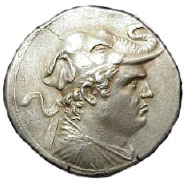
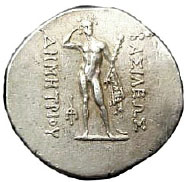
Tetradrchm of Demetrios I c. 200 - 190 BCE
Obverse: Draped bust wearing elephant scalp headdress.
Reverse: Herakles holding club and lion's skin.
Menander
c.155-130 BC
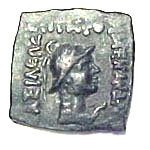
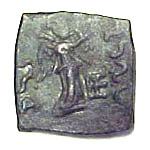
Square Copper coin of Menander c.155-130 BCE.
Obverse: Helmeted bust of Menander.
Reverse: Nike.
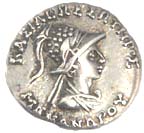
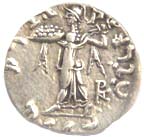
Menander. Silver Tetradrachm . c.155-130 BCE.
Obverse: Helmeted bust of Menander.
Reverse: Athena standing with a shield and thunderbolt.
A short list of Indo - Bactrian Kings.
|
Antimachos I (c.185-170 BCE) Demetrios II (c.175-170 BCE) Menander (c.155-130 BCE) Plato (c.145-140 BCE) Zoilos I (c.130-120 BCE) Strato I (c.130-110 BCE) Polyxenos (c.100-95 BCE) Demetrios III (c.100 BCE) Epander (c.95-90 BCE) |
Meander II Dikaios (c.90-85 BCE) Artemidoros (c.85 BCE) Apollodotos II (c. 80-65 BCE) Hippostatos (c.65-55 BCE) Dionysios (c.65-55 BCE) Zoilos II (c.55-35 BCE) Apollophanes (c.35-25 BCE) Strato II (c. 25-10 BCE) |
(Complete list of Bactrian Kings is in the ancient Greek section)
Previous |
Ancient Country List |
|
|
Index |
|
Home |
|
|